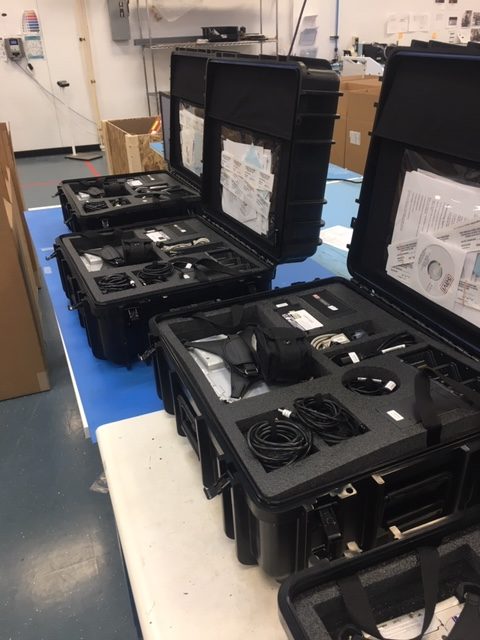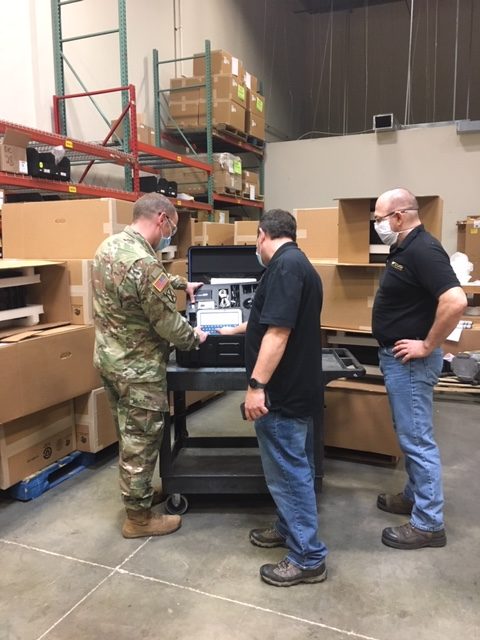As the CEO of a supply chain visibility technology company, I am well aware of the irony of my own firm becoming a victim of supply chain disruption. But as the world deals with the immense and unprecedented impact of the coronavirus, even Savi was not able to avoid supply chain issues.
When your customer is the U.S. Department of Defense (DoD), and your product is critical logistics technology for the Army National Guard’s first responders and warfighters, however, failing to deliver is simply not an option.
Here’s the story of how Savi, our suppliers and the DoD teamed up to work through coronavirus chaos to get asset-tracking technology to the Army National Guard.
How 3 Organizations Worked Together to Get New Logistics Equipment to the Army National Guard – in the Midst of A Pandemic
Supporting the U.S. DoD’s Mission with Asset Tracking Technology
Savi is proud of our more than 30 years’ history as a trusted supplier to the DoD. Currently, Savi is the sole provider for the military’s active RFID-IV (aRFID IV) contract, which Product Lead Automated Movement and Identification Solutions (PL AMIS) manages. The aRFID IV contract provides U.S. government agencies and allied partners with state-of-the-art global asset tracking and in-transit visibility hardware, software and integration services.
Portable deployment kits (PDKs) are among the key military asset-tracking products available. Warfighters in the field can use PDKs to monitor assets in even remote areas around the world.
The newly released, cutting-edge Savi PDK III gives military warfighters and first responders a lighter and leaner logistics footprint in even the most austere, hostile environments. The PDK III is not only cutting-edge technology – it’s also less expensive than previous versions.

3 Savi PDK III units
(Readers with CAC can learn more about the PDK upgrade process in the April 2020 edition of the AMIS ITV Operations and Training newsletter.)
The Army National Guard’s order of 221 units for $3.2 million and an additional Army Reserve order for 354 units for $5.1 million are the first large-scale purchases of the new Savi PDK III.
As first responders to the coronavirus crisis in the U.S., maintaining in-transit visibility capabilities during deployments is critical for both the Army National Guard and the Army Reserve.
It was clearly urgent that the Army National Guard get its new equipment on time.
Contingency Planning & Coronavirus: Overcoming Manufacturing Supply Chain Disruption During a Pandemic
Normally, military equipment delivery can take several months. It involves a number of suppliers working together to manufacture dozens of kit components, assemble all of those pieces, and test the completed units. Once assembled, we then ship the units to the specific military customer, who then inspects the kits to confirm everything is in good order.
The Army National Guard’s order for 221 PDK IIIs was no different – but this time, my team was working to pull together complex technology in the middle of a global pandemic.
Around the world, airlines were cutting passenger flights which also meant less air freight capacity. Manufacturing plants were shutting down. Governments began imposing strict measures limiting movement.
We faced a triple whammy – 1) difficulty getting materials into plants to manufacture components, 2) a struggle getting workers in to build the necessary parts, and 3) finally, no guarantee we’d be able to get our finished products out. We, like so many of our own customers and manufacturers around the world, had a big, complicated supply chain challenge to face.
Knowing both the obstacles to an on-time delivery and the critical importance of that delivery, PL AMIS asked Savi to be creative and flexible to find solutions. We agreed to cooperate to figure out ways around the many logistics issues in this challenging environment.
I’m proud of our team – they brilliantly rose to that challenge. And it was tough. Just as we’d solve one issue, another one would pop up – supply chain “whack-a-mole.”
We tried to ramp up shipping some key parts, only to get blocked by our carriers. Several people sat up long into the night, negotiating with the carriers so we could get these components – critical to the DoD’s mission – out of one factory and to the next for assembly. Persistence led to success!
Or so we thought. Just as we got the air cargo carrier to guarantee us some space on a plane, the plant manufacturing those parts was put under shutdown orders.
Back to the phones, this time to negotiate both with local government authorities and our own supplier. We were able to convince the authorities that our manufacturing need was critical, and our supplier showed its own flexibility, too. The compromise we arrived at was remarkably unusual: our manufacturing supplier would obey the shutdown order by having workers temporarily live at the factory and build these parts in isolation. Yes, our partners’ employees camped at the factory!
Only in extremis would you ask people to make that kind of sacrifice – but we are in uncharted waters with this coronavirus. I’m blown away by the commitment our supplier and its employees showed. We could not have met our obligations without them going above and beyond to get us these parts.
I’m lucky to have really smart, talented people on my team, who put a lot of thought and effort into a number of contingency plans. With pandemic response changing “business as normal” on a daily and sometimes hourly basis, we had to prepare for anything and everything to make sure we got our kits together.
Some of what we came up:
- Get the parts out – while we still could – and complete assembly elsewhere
- Find alternate suppliers for individual components
- Make them ourselves
Believe me, we really, really did not want things to come to #3. That option would have entailed the Savi team making one part at a time with 3D printing! We were prepared, however, to do whatever it took to get these kits to the Army National Guard.
Luckily, our original contingency plan of having a small, dedicated workforce live onsite at the plant to get these parts completed and shipped worked….Once we shared with our manufacturing partners documentation explaining that the kits were for the DoD’s first responders.
Private-Public Problem-Solving to Get In-Transit Visibility Kits to End Customer
Meanwhile, we had two more challenges once we got those critical parts manufactured and out for assembly. First, the assembly site – the Maryland location of First Source Electronics (FSE), a division of Commercial Vehicle Group, Inc. – was also put under shutdown orders. Out of the frying pan, into the fire. But at least we now had some experience persuading local authorities to grant exemptions to make our mission-critical devices.
FSE did a great job negotiating with Maryland state authorities to get an exemption so they could get the parts assembled into finished kits.
A key part of that exemption helped us solve the last challenge: getting the kits to the Army National Guard Bureau (NGB) customer so NGB could inspect and accept the kits, completing the delivery process. Normally, we would ship the kits, the customer inspects and then accepts. That can take weeks at the best of time – and we’d already experienced delays due to all the previous logistics challenges, and shipping within the U.S. was no picnic.
The Army NGB customer, however, agreed to a change in normal inspection procedure to expedite the acceptance process. Captain Adam Hever traveled to FSE’s Maryland location to inspect and accept the kits in person. We of course kept the onsite inspection team small to help with in-person prevention strategies!

CPT Hever, Savi’s Doug Schreffler & FSE’s Chris Macek inspect PDK III units
As FSE’s VP/Managing Director Kevin Popielarczyk said in the press release we put out to share this coronavirus supply chain success story with the world, the support Maryland’s Governor Hogan and the flexibility the Army National Guard Bureau demonstrated “saved valuable time in our country’s crisis management.”
This really was “the best of private/public partnerships,” as my own colleague Rosemary Johnston said. Multiple government organizations worked with multiple private companies to find a way to get this done.
The coronavirus’s global impact has created unprecedented challenges, with bottlenecks at every step in the supply chain. As Winston Churchill said, “A pessimist sees the difficulty in every opportunity; an optimist sees the opportunity in every difficulty.” For the dedicated teams who collaborated on this order, adversity couldn’t stop us – it stimulated our creativity and determination.
The coming months are bound to present more challenges for manufacturers worldwide. As we try to figure out all the questions coronavirus asks of businesses and society as a whole, I’m glad to know my Savi team has the grit and ingenuity to see these challenges as opportunities to shine.
About the Author: Rich Carlson is Savi’s CEO. With over 20 years’ experience in the software and wireless space, Rich oversees Savi’s strategic planning, go-to-market strategies, and revenue generation. He founded the Neon Dolphin Technology Group, a consultancy that advises and helps grow Internet of Things (IoT) technology and software firms in 2012, and prior to that spent eight years as CEO at Wireless Matrix Corporation, where he transformed the business from a niche satellite provider to a leader in the fleet management software-as-a-service (SaaS) industry.

